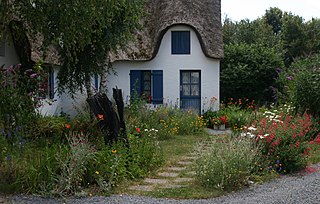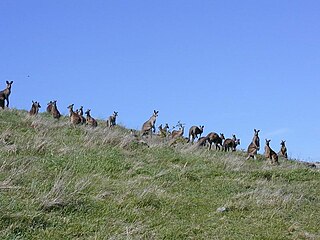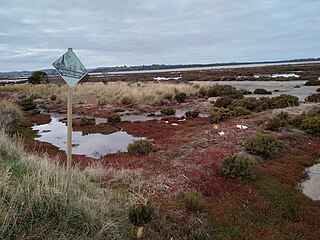Related Research Articles

Conservation in Australia is an issue of state and federal policy. Australia is one of the most biologically diverse countries in the world, with a large portion of species endemic to Australia. Preserving this wealth of biodiversity is important for future generations.

Wildlife gardening is also known as "habitat gardening", or "backyard restoration".
The Backyard Wildlife Habitat is a program of the National Wildlife Federation that encourages homeowners in the United States to manage their gardens and yards as a wildlife garden, with the goal of maintaining healthy and diverse animal habitats and ecosystems. The program began in 1973. By 1998, it had impacted more than 21,000 yards and, as of 2006, has certified over 60,000 'backyards'.

The Environment Protection and Biodiversity Conservation Act 1999(Cth) is an Act of the Parliament of Australia that provides a framework for protection of the Australian environment, including its biodiversity and its natural and culturally significant places. Enacted on 17 July 2000, it established a range of processes to help protect and promote the recovery of threatened species and ecological communities, and preserve significant places from decline. The Act is as of June 2020 administered by the Department of Agriculture, Water and the Environment. Lists of threatened species are drawn up under the Act, and these lists, the primary reference to threatened species in Australia, are available online through the Species Profile and Threats Database (SPRAT).
Bird Observation & Conservation Australia (BOCA) was a club established on 12 April 1905 by members of the Royal Australasian Ornithologists Union (RAOU) in Melbourne, Victoria, as the Bird Observers Club. Although inactive for many years, in 1927 it was revived and subsequently active until the end of 2011 when it merged with Birds Australia to form BirdLife Australia. It published a quarterly journal, Australian Field Ornithology, and a quarterly newsletter, the Bird Observer. It had a cooperative relationship with the Land for Wildlife program, a voluntary conservation scheme for private land in Victoria, which was instigated by two prominent club members, Ellen McCulloch and Reg Johnson, established in 1981, and coordinated by the Victorian Department of Sustainability and Environment.

Natural resource management (NRM) is the management of natural resources such as land, water, soil, plants and animals, with a particular focus on how management affects the quality of life for both present and future generations (stewardship).

Serendip Sanctuary is a 250 ha protected area in Victoria, Australia, near the You Yangs and the town of Lara, some 22 km north of Geelong and 60 km south-west of Melbourne. Originally used for farming and other purposes, it was purchased in 1959 by the State Government of Victoria for wildlife research and the captive management and breeding of species threatened in Victoria, such as the brolga, magpie goose, Australian bustard, and bush stone-curlew. The sanctuary contains many different types of wetland and is home to many plant species as well, such as river red gums, tall spikerush, and tussock grass. Serendip now focuses more on environmental education about the flora and fauna of the wetlands and open grassy woodlands of the Volcanic Western Plains of Victoria. It was opened to the public in 1991 and is now managed by Parks Victoria.

Lewin's rail is a species of bird in the family Rallidae. It is also known as the water rail, Lewin's water rail, Lewin's grind rail, slate-breasted rail, slate-breasted water rail, pectoral rail, pectoral water rail, short-toed rail and short-toed water rail.

The Australian Wildlife Conservancy (AWC) is an Australian independent, nonprofit organisation, working to conserve threatened wildlife and ecosystems in Australia. This is principally achieved through the acquisition of extensive areas of land on which to establish conservation reserves ("sanctuaries") or by entering into partnerships with government, Indigenous groups, and private landholders to manage landscapes for effective conservation. AWC is the largest private owner and manager of land for conservation in Australia, currently managing 31 sanctuaries and partnership sites for wildlife conservation that cover over 6.5 million hectares of land across Australia.
Private landowner assistance program (PLAP) is a class of government assistance program available throughout the U.S. for landowners interested in maintaining, developing, improving and protecting wildlife on their property. Each state provides various programs that assist landowners in agriculture, forestry and conserving wildlife habitat. This helps landowners in the practice of good land stewardship and provides multiple benefits to the environment. Some states offer technical assistance which includes:

The Paroo-Darling National Park is a protected national park that is located in the Far West region of New South Wales, in eastern Australia. The 178,053-hectare (439,980-acre) national park spans two distinct regions in the outback area. This region covers the arid catchments of the Paroo River and the Paroo-Darling confluence to the south.

Established in 1965, the Yellingbo Nature Conservation Reserve is located 45 km east of Melbourne in the Upper Yarra Valley, near the towns of Yellingbo, Launching Place, Yarra Junction, Hoddles Creek, Cockatoo, Emerald, Monbulk and Seville. Yellingbo Nature Conservation Reserve is a narrow riparian reserve with stream-frontage land along the Woori Yallock, Shepherd, Cockatoo, Macclesfield and Sheep Station Creeks.

The Yanga National Park is a newly formed national park, located near the township of Balranald in south- western New South Wales. It covers an area of 66,734 hectares which includes 1,932 hectares of Yanga Nature Reserve, and has a frontage of 170 kilometres (110 mi) on the Murrumbidgee River. It is largely located in the Lower Murrumbidgee Floodplain, which is included on A Directory of Important Wetlands in Australia because of its importance as a breeding site for waterbirds when flooded.
Pungalina-Seven Emu Sanctuary is a 3060 km2 private protected area in the Northern Territory of Australia. It is managed by the Australian Wildlife Conservancy (AWC) which purchased Pungalina Station in 2009, with some assistance from the Wildlife Australia Fund. It adjoins the Gulf of Carpentaria near the border with Queensland, lying in the Gulf Coastal bioregion. The reserve is bordered by Calvert Hills and Wollogorang Stations to the south and east. The nearest town is Borroloola, 150 km to the west.

A sustainable wildlife enterprise is a farming system that incorporates sustainable use of wildlife to promote conservation. In Australia, landholders work together across boundaries to sustainably harvest or make use of (ecotourism) naturally occurring wildlife populations such as the kangaroo. Important to the concept is that biodiversity and environmental benefit occurs via alternative land uses. Attaching a value to native resources through commercial development has the potential to provide alternative sources of income, especially in areas where traditional systems are no longer as profitable or environmentally sustainable. The Sustainable Wildlife Enterprise system enables farmers to realise the financial value of native wildlife such as the kangaroo and encourages them to manage their land that supports the source of the income without lowering total farm profitability – hence contributing to habitat and biodiversity conservation. The Sustainable Wildlife Enterprise system has been developed in Australia but is based on world-wide experiences.
Ellen Margery McCulloch OAM was a Melbourne-based Australian nature writer and amateur ornithologist who had a long association with Bird Observation & Conservation Australia.
Harold Reginald (Reg) Johnson was an Australian cartographer, amateur ornithologist and environmentalist.

The Cheetham Wetlands are 420 hectares of artificial and natural lagoons, created on old salt works land on the western shores of Port Phillip Bay, Australia. The wetlands are approximately 20 kilometres (12 mi) southwest of Melbourne, and sit within the Municipal Councils of Hobsons Bay and Wyndham City.
Lindy Lumsden is a principal research scientist with the Department of Environment, Land, Water and Planning, at the Arthur Rylah Institute for Environmental Research, in Melbourne, Australia.

In 2010, Australia formulated a strategy for conserving land under the National Reserve System, which would be "a national network of public, Indigenous and private protected areas over land and inland water". States, territories and the commonwealth have enacted legislation to create and protect private lands "in perpetuity". Additionally, they have created mechanisms to fund the conservation of biodiversity in the shorter term. See for example, The Two Rivers Catchment Reserve.
References
Notes
Sources
- Anon (2006). "Vale to Ellen McCulloch OAM, birdwatcher, conservationist and Land for Wildlife crusader" (PDF). Land for Wildlife News. 5 (10): 9.
- "Land for Wildlife". Department of Sustainability and Environment, Victoria. Retrieved 14 May 2011.